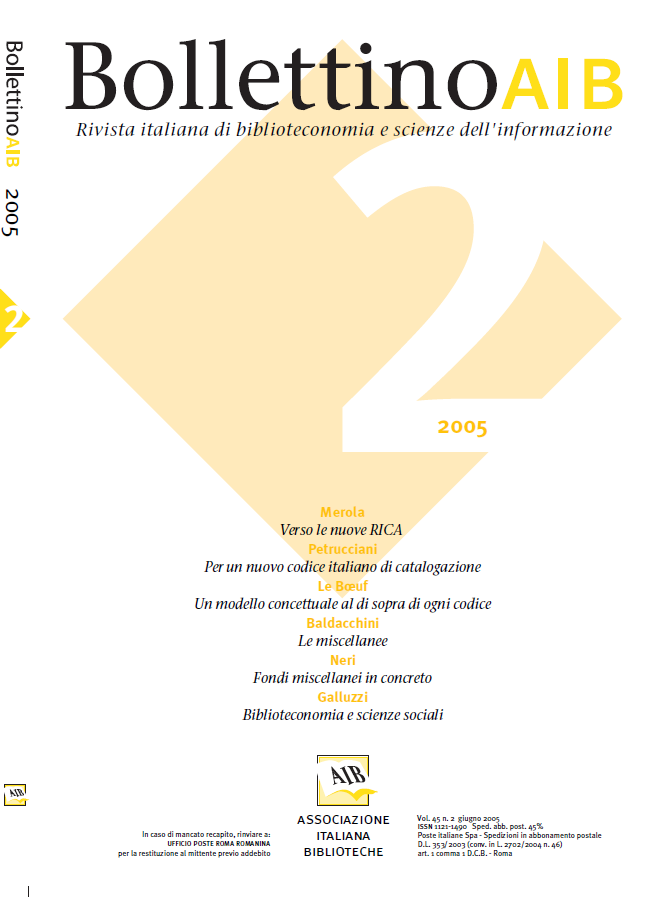Miscellaneous collections: some concrete situations
Main Article Content
Abstract
The characteristics and organization of miscellaneous material have not been the object of particularly careful reflection in recent years, although they often represent a considerable part of the patrimony of a library with ancient collections. This can be explained mainly by the fact that over the centuries the texts of miscellanies were often considered documentation of secondary importance which was thus treated with less scrupulous criteria. The lack of interest with regard to this documentation is confirmed by a certain imprecision of librarianship language for the definition of the term "miscellany", which, as has been pointed out, is used for indicating the correspondent literary genre, or a work formed of short texts by one or more authors regarding various subjects, but which can also mean an "artificial volume", that gathers together pamphlets or loose pages and finally the pamphlet itself, inasmuch part of it.
In point of fact "miscellaneous" literature appears to be linked to eighteenth century encyclopaedism and the strong need to rationally arrange knowledge and, therefore, the documents that contain it. It is not by chance that the term reappears in the titles of periodicals, actually more as a compliment to a scholarly tradition than as the fruit of the correspondence between two genres. Artificial miscellany is, on the other hand, a unicum, inasmuch as it is a collection of pamphlets and editions that do not necessarily have a similar appearance, whereas a periodical expresses a continuity that is its very essence.
The main aim of the research study, initiated as a result of the I level Master thesis "Conservation and management of archive and library collections", academic year 2002-2003, of the Faculty of Conservation of cultural heritage of the University of Bologna, branch of Ravenna, was that of beginning to understand and reconstruct the characteristics peculiar to miscellaneous volumes, the criteria according to which the editions were bound together and the conservative treatments and procedures that libraries had reserved for them. The miscellaneous material of four libraries was examined for these reasons: the Angelica and the Casanatense of Rome and the Archiginnasio and University Library of Bologna. The analysis of the collections of these four libraries made it possible to demonstrate a series of possible methods of approach which, taken into consideration during the description of artificial material, could contribute to representing the volume as a whole, without neglecting any element. As emerges from the editions mentioned in the appendix, it would also be useful to distribute a type of description organized at various levels, according to the characteristics of the document and of the instruments available to the research scholar.
In point of fact "miscellaneous" literature appears to be linked to eighteenth century encyclopaedism and the strong need to rationally arrange knowledge and, therefore, the documents that contain it. It is not by chance that the term reappears in the titles of periodicals, actually more as a compliment to a scholarly tradition than as the fruit of the correspondence between two genres. Artificial miscellany is, on the other hand, a unicum, inasmuch as it is a collection of pamphlets and editions that do not necessarily have a similar appearance, whereas a periodical expresses a continuity that is its very essence.
The main aim of the research study, initiated as a result of the I level Master thesis "Conservation and management of archive and library collections", academic year 2002-2003, of the Faculty of Conservation of cultural heritage of the University of Bologna, branch of Ravenna, was that of beginning to understand and reconstruct the characteristics peculiar to miscellaneous volumes, the criteria according to which the editions were bound together and the conservative treatments and procedures that libraries had reserved for them. The miscellaneous material of four libraries was examined for these reasons: the Angelica and the Casanatense of Rome and the Archiginnasio and University Library of Bologna. The analysis of the collections of these four libraries made it possible to demonstrate a series of possible methods of approach which, taken into consideration during the description of artificial material, could contribute to representing the volume as a whole, without neglecting any element. As emerges from the editions mentioned in the appendix, it would also be useful to distribute a type of description organized at various levels, according to the characteristics of the document and of the instruments available to the research scholar.
Article Details
Section
Articles

This work is licensed under a Creative Commons Attribution-ShareAlike 4.0 International License.
